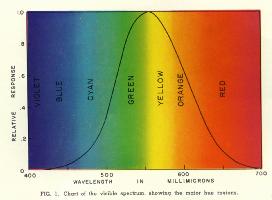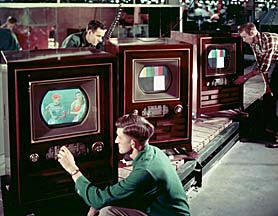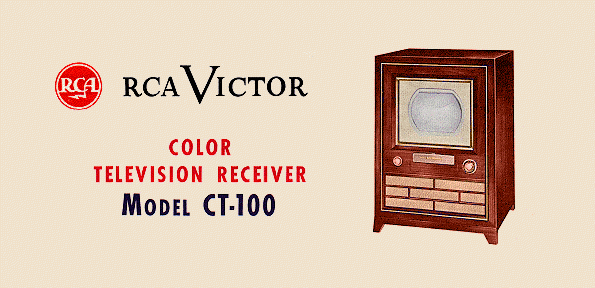The 1950's Gave Use Color Television
It Was A Great Time To Be Alive!
Color Television, What Next???
We were the first on our street to have Color TV. Dad was kind of a gadget nut and it was fun to try the new items which were entering the consumer community.

In 1953, the FCC dropped the CBS color broadcast standard in favor of a system developed by the Radio Corporation of America (RCA). Named after the National Television System Committee, an FCC body that proposed the standard, NTSC is still used in North America and Japan. Later in the year, NBC -- at that time an RCA subsidiary -- aired its first color broadcast, a program starring Kukla, Fran, and Ollie and the Boston Pops. In 1954, CBS and NBC began regular color broadcasts even though only one percent of U.S. households owned a color television.

Starting in 1957 until the beginning of the 1962-63 TV season, every NBC color broadcast began with the colorful animated NBC Peacock which reminded viewers that "The Following Program is Brought to You In Living Color on NBC!"
Keep in mind that NBC was owned by television set manufacturer RCA. No doubt the Peacock, which looked pretty drab on old-fashioned black and white TV's, sold countless RCA color sets like the one shown here
RCA was the only name I ever knew... but there was "Mad Mad Muntz" now that I think about it!.

We got our first color TV in about 1954. There was a mix of B&W and color programs on the air. The thing I most remember was that the TV could not be moved once it was set up! The fellow that came out with the TV admonished Mom..."Never, never move it"... Well... you know Mom ... she moved it all around the house!
The NBC chicken was exciting to see... not all stations were color in those days... so when a program started and the NBC chicken (peacock) spread his feathers, it was time to call everybody to the set!
The word television literally means "vision at a distance." We like to think of a television screen as a "window" through which a televiewer can watch a scene that may be taking place many miles away.
CT-100 RCA Color TV - 1954

Starting March 25, 1954, 5,000 CT-100's were manufactured in RCA's Bloomington, Indiana plant. The set was named, "The Merrill". By mid-April of 1954, the sets were available at dealers. RCA released the CT-100's service literature, "1954 No. T3", on March 31, 1954.
The cost.... $1,000! Using the inflation calculator for the year 2013 that would be the equivalent of $8,620.69.
RCA also published a Television Service Clinic booklet, "Principles of Color Television and Technical Features of the RCA Victor Model CT-100 Color Television Receiver".
This excellent 55 page booklet also covers purity and convergence adjustments.

The inside was terribly complex and dangerous!
There is a reason for the amazing Technicolor-like picture of the CT-100. The CT-100's shadow mask CRT used color phosphors with correct chromaticity corresponding to the NTSC standard. The red and green of the CT-100 is more rich and saturated than the orange-red and yellow-green of modern sets. This results in the larger color gamut of the CT-100. The CT-100's 15GP22 color kinescope provided a rounded side 11 1/2-inch wide by 8 5/8-inch high picture with an area of approximately 100 square inches. A planar shadow mask and flat phosphor screen with decorative mask were suspended inside the round glass envelope. CBS Hytron would later develop the technique to manufacture a curved shadow mask and to deposit color phosphor dots directly on the inside of the face plate. With its 45-degree deflection angle the CRT was 26-inches long. The 15GP22 used electrostatic convergence and required external customer static convergence and focus adjustment knobs on the left side of the cabinet.
The CT-100, with a 16-position turret tuner, could receive any combination of VHF and UHF channels and provided a 45.75 MHz picture and 41.25 MHz sound IF output. Seven IF stages were used to minimize amplitude and phase distortion over the 4.5 MHz bandwidth. A conventional horizontal "SynchroGuide" provided horizontal sync and drove a 6CD6 output tube. The high voltage power provided 19,500 volts to the CRT by use of a 3A3 rectifier and 6BD4 shunt regulator. The set consumed 475 watts.
The CT-100's complex 36 tube chassis, numbered "CTC2", used wide-band I and Q color demodulation for higher color resolution. Synchronous low level 1.5 MHz I demodulation and 0.5 MHz Q demodulation and phase spli tting derived red, blue, and green signals by I, Q, and Y matrixing methods. It is ironic that 45 years after the introduction of this set, there is still little use by modern receivers of the orange-cyan visual acuity information in the NTSC color signal. Color synchronization was achieved by a conventional AFC circuit with a phase detector and reactance control of a crystal oscillator. The CT-100's color quality is indeed amazing when seen on one of today's few remaining operational sets.
tting derived red, blue, and green signals by I, Q, and Y matrixing methods. It is ironic that 45 years after the introduction of this set, there is still little use by modern receivers of the orange-cyan visual acuity information in the NTSC color signal. Color synchronization was achieved by a conventional AFC circuit with a phase detector and reactance control of a crystal oscillator. The CT-100's color quality is indeed amazing when seen on one of today's few remaining operational sets.
The set retailed for $1,000. When the 21-inch 21-CT-55 was introduced in December of 1954, the price for the many unsold CT-100 sets was reduced to $495. The cost was $1000. which would be about $6000. in 2007 dollars.
Color TV Antennas
Muntz
Although Muntz pretended to be a madman, he was actually a shrewd businessman and built up a large fortune selling everything from autos to radios. He had a sharp eye for taking the cost out of the products he marketed so relentlessly, and his practice of reducing any device to the minimum number of components needed to function became known as "Muntzing".

"Muntzing" had its advantages. In the early 1950s, many brands of television receivers had upwards of 30 tubes in the chassis. By trial and error, Muntz developed a television chassis that gave an acceptable monochrome picture with 17 tubes. Marketed under the name "Muntz", the simplified receivers sold very well for a while, and exhibited good reliability, as the reduced number of tubes created much less heat. They worked well in metropolitan areas, close to television transmission towers where signals were strong, but due to the reduced component count worked poorly with weak signals, as most of the components Muntz left out of his design were those intended for improved performance in fringe areas.
This was a calculated move by Muntz: He preferred to leave the low volume, high performance television receiver market to firms such as RCA and Zenith Electronics , as his intended customers were primarily urban dwellers with limited funds to spend on a television receiver.
Engineers still tell stories about him. He was known to carry wire clippers in his pocket, for instance, and if he saw that one of his engineers had put a component he considered superfluous into any of his products, he would just snip it out. In his attempts to combine two of his main product lines, cars and stereos, he invented the Muntz Stereo-Pak 4-track tape cartridge, a direct predecessor of the 8-track cartridge developed by Bill Lear . The 8-track cartridge became the standard for prerecorded mobile audio for two decades.